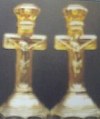Carnival Glass 101 | home Quick Reference to Carnival Glass Patterns on This Site
US Glass - Part 6
UNITED STATES GLASS COMPANY ~~ Part 6
Contradictory Information surrounding ~ INTERIOR RAYS Pattern
The “learn as we go process” while collecting carnival glass is quite amazing, really. Each generation seems to profit from earlier information. As improved communication provides updated research, new channels of thought prevail.
Earlier accounts written by those interested in vintage carnival glass did not offer much notice to the “just marigold depression-type glass”. Until research advanced into several wholesale catalogs, knowledge was scant or non-existent, so far as determining years of manufacture and marketing.
Utilized and broken in that use, much of it has been eliminated, whereas the earlier examples (1907-1920) have been preserved for their design. That very act of daily, practical usage and lack of respect for “preservation”, inhibits application of appropriate “name identification” in many cases.
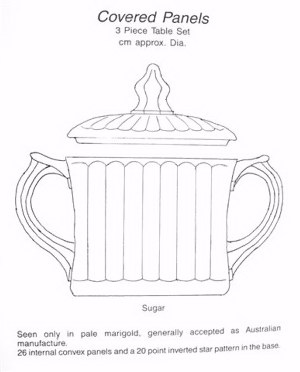 |
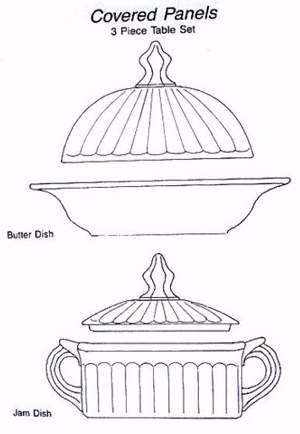 |
Page taken from CARNIVAL GLASS of AUSTRALIA.
|
Taken from an account in the CARNIVAL GLASS of AUSTRALIA book.
|
When the Book Committee compiled data for the Carnival Glass of Australia, produced by Australian Carnival Enthusiasts Assoc. Inc., copyrighted 1988, thoughts were that COVERED PANELS, at least in the 3-piece table set had been produced by Crown Crystal Glass Co. of Sydney.
Currently, this pattern known as INTERIOR RAYS is being attributed to U.S. Glass. It would be difficult to pinpoint which of the factories within the conglomerate may have been responsible for production.
Please NOTE: Those examples having lids, reveal interior rays, perhaps explaining the pattern name. The number of rays will necessarily vary according to the size and shape of the piece involved. In consideration of the fact that these articles were created for practical, utilitarian use, rather than decorative, we might consider that “function” was the leading factor in design. Many of the molds used for this type of glassware produced during the late `twenties and early `thirties was first created in clear glass, with the marigold examples very likely intended to “enhance sales” and perhaps extend interest in use of the products, apart from the “collecting sense” we attain from earlier iridized glass.
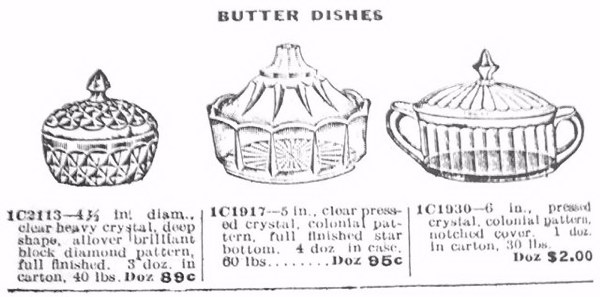 |
|
Butler Bros. Catalog Mid-Winter, 1927
|
|
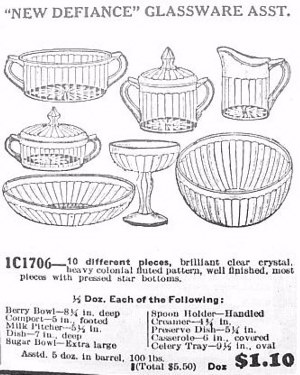 |
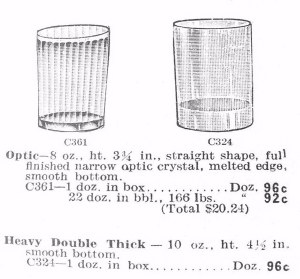 |
INTERIOR RAYS as seen in the April 1929 Butler Bros. Wholesale Catalog. While examples are in crystal, the ad does display some of the shapes within the pattern.
|
Spring 1920 Butler Bros. Ad
|
We display three ads which appeared in the BUTLER BROTHERS WHOLESALE CATALOGS indicating manufacture in the United States.
In our search through the Butler Brothers Wholesale Catalog Reprint, containing glass sections gleaned from 42 different issues, along with eight additional copies of that same Catalog, and one from Charles Rouss, we find the earliest ad from Spring 1920 Butler Bros.Catalog No.1752 shown above, to contain a semblance of the tumbler in 8 oz. size. Much the same ad is repeated through to the April 1931 Butler Bros. issue. In none of these Catalogs can we locate a semblance of the pitcher. In all cases, the ads are for crystal examples, leading us to believe that the marigold examples may have been iridized in an “after-market” effort……….at least in some cases.
There are several other known Wholesale distributors whose catalogs have never been released into public hands, which may offer more conclusive clues into the origin of patterns found on such as the pitcher/tumbler seen in this segment. Access to many such publications are restricted to certain public libraries and museums around the United States. We do know that not all manufacturers of iridized glass, marketed their wares through the same wholesale venues.
Consider the possibility that since we know moulds to have changed hands (sometimes more than once) over the years, more than one manufacturer may have marketed the same pieces at differing times during the ten or so years the depression-type glassware was in favor with the public. With this in mind, application of a single pattern name may possibly be somewhat out of the question. In most instances, the mere survival of these examples without severe damage, should provide sufficient pleasure for the collector!----BE Happy!
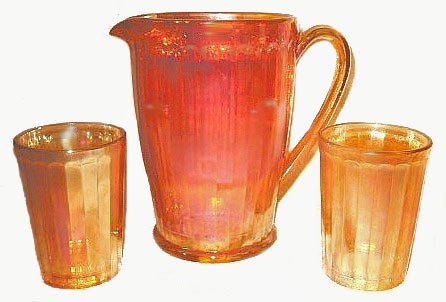 |
|
INTERIOR RAYS Pitcher and Tumblers -
|
|
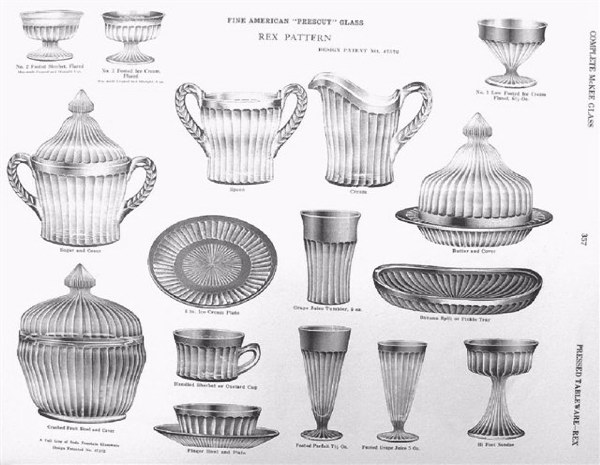 |
|
Ad from COMPLETE BOOK of MCKEE,showing the handles with vining influence.
|
However, the name REX was applied to this design, as early as when the Hartung Books were compiled. Hartung Book # 8, page 47, states that its origin is McKee Glass Co., referring to a “vine pattern running the length of the handle”.
Close inspection reveals NO such vine effect in the set we picture. Unfortunately, errors in judgement and miscalculation found in many early books written about carnival glass can only be refuted with proper evidence to the contrary. (Please see attached page 357, taken from: The Complete Book of McKEE Glass - by Sandra McPhee. It should correct all previous misconceptions).
Page 330 of the McKEE book by McPhee relates the following: " Most of the pressed tableware patterns were made by hand, the majority of the patterns shown here were issued prior to the company switch-over to a machine-made operation. The early patterns (11 listed) were of 1870-1885 vintage. The REX pattern was granted a design patent on July 13, 1915. It was not only a consumer line but was also offered to the industrial trade which includes hotels, cafes, and restaurants. REX was still listed in 1927 with ground bottoms."
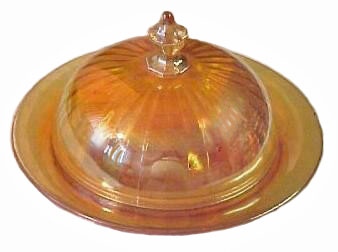
INTERIOR RAYS Butter or Cheese Dish
The butter dish , while reportedly appearing in a Hazel Atlas Catalog, may or may not be verified as a product of that company. Close examination of the drawings which appear in the CARNIVAL GLASS of AUSTRALIA certainly lead us to believe that U.S. Glass may have manufactured that piece, as well. A little closer observation to all the knobs on the various pieces are further indication that they all derive from the same manufacturer. Agreed?
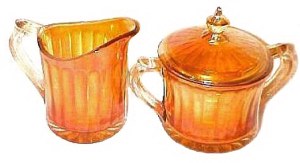 |
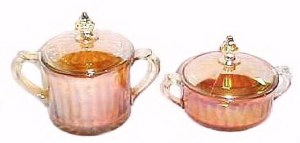 |
INTERIOR RAYS by US Glass-Creamer & Sugar
|
INTERIOR RAYS Covered Sugar and Jam Dish
|
Notice the flat apertures extending from the topside of the handles on the sugar, creamer , spooner, jam dish and compote. All our “leads” direct attention to an American producer.
INTERIOR RAYS Covered Sugar and Covered Jam Dish: measurements are: Sugar - 6” tall x 4 ¼” across, Jam Dish - 4 ½” X 4 ½” across. The 1927 Butler Bros. Ad offers fresh insight into uses and possibilities for the “jam dish”.
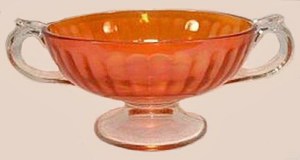 |
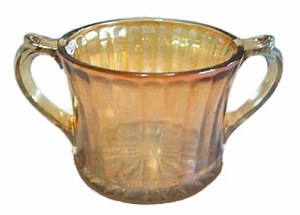 |
INTERIOR RAYS Compote or Bonbon
|
INTERIOR RAYS Spooner or Sugar Base - 3 1/4 in. x 6 1/2 in.
|
INTERIOR RAYS Handled Compote/Bonbon and Spooner: - another of the marigold offerings in this very practical “depression-type” pattern.
While we concede that the water set, open compote/bonbon, and spooner appear to have a somewhat differing panel/rays appearance, we display them here until more solid evidence of definite origin can be arrived at.
Should any of our viewers have more light to shed on this subject , we shall be happy to hear from you. One of the nicest aspects surrounding an educational site is the fact that printed material can be updated rather quickly when need arises.
Dean & Diane Fry-3-06
In the parable of the talents, Jesus illustrated that each of us has been given varying gifts and resources, and we are each expected to be productive with what we have.
(Matthew 25:14-30)
As we draw near to Christ
We are drawn near to each other.

Should you care to contact the Frys, their email address is:
Search Our Sites
back to Carnival Glass 101
Our other sites you may enjoy:
Everything you EVER wanted to know about Indiana Glass
Great Reference for Newer Carnival Glass.
Complete Glassware Catalogs Available to Download
Questions? Comments? Suggestions? Broken Links? Corrections?
Your Friendly Webmaster is here to help!
